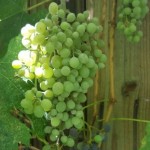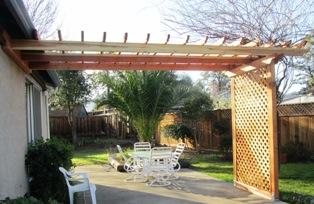The Summer Garden Is Done, What’s Next?
My summer garden is wild and chaotic and bountiful at the beginning of the season. You’ll find fruit trees, vegetables, vines of melons, corn, and perennial lavender and other showy herbs and flowers. Like a grand dame of faded elegance, the garden has matured and looks a bit weary and spent now that Labor Day approaches.
Just because the peak growing season is coming to an end, it’s not the end of garden chores. The following tasks can be started now.
HARVEST AND STORE
For some crops, the harvesting goes on. Examples include tomatoes, potatoes, melons, and winter squashes like Butternut that store well. If you haven’t already harvested the garlic, it’s a good time to do that.
Cut sunflower seed heads and place them in a warm area to dry. Collect seeds from cosmos, nasturtiums, and other flowers to preserve for next year’s garden. Work out storage options, especially for food items to be harvested.
Snip summer table grapes and other varieties if they are ripe . . . or let them hang a while longer for extra sweetness.
CLEAR BEDS
Depleted, dying, or dried annuals can be dug, pulled, and composted now. If you plan to let the garden rest, plant a cover crop so the ground doesn’t become hard scrabble. The cover crop will feed the soil.
DO FALL PLANTING
If you intend to do a fall planting, take time now to enrich the earth with amendments. Turn and rake the garden soil. Put plants directly into the prepared earth and water well to get them off to a good start.
For quick second crop before the weather turns cold, plant greens such as spinach, kale, and arugula. Cool season crops like beets, broccoli, and cabbage can go directly into the ground now, too.
CUT FLOWER AND SEED HEADS
Cut flower heads of hydrangeas for drying. Insert plant markers near peonies and other perennials that will die completely back during winter. Gather bunches of mint and other herbs, tie with string, an hang in a cool, dark place to dry.
CREATE MULCH
Designate an area to create a new compost pile. Use garden detritus and fall leaves as the trees begin to drop their canopies to enter winter dormancy. The resulting mulch will enrich the soil for next year’s garden.
CHECK ON FALL PRODUCE
Pomegranates, persimmons, and pumpkins will soon be ripening. Ensure that these plants continue to get water. Check for pests and any signs that might indicate nutrient deficiencies that could show up in the leaves. Figure out your options for storing or gifting excess fruits and veggies. For example, pomegranates keep well in the fridge or remove the seeds and put into bags for freezing. Save and dry rinds for potpourri.
TURN THE SOIL IN GROW BOXES
Aerate and amend soil in grow boxes and raised beds for cool season crops. Do these chores before the rainy season and cool weather arrives. Your garden, like a young maiden who flourishes from attention, will produce bountiful vegetables, fruits, berries, and flowers during its next growing season.
_______________________________________________________________
If you enjoy reading about farmette topics, gardening, and keeping chickens and honeybees, check out my series of cozy mysteries from Kensington Publishing in New York.
Click on this link: http://tinyurl.com/ya5vhhpm
My newest nonfiction book is published by Adams Media/Simon & Schuster: http://tinyurl.com/y9vfw2t9
- Anyone can find peace, clarity, and focus…all it takes is a moment
Growing Your Own Superfoods
Nutrient-rich fruits, vegetables, and berries are not difficult to grow. Some can even be grown in containers on a sunny patio. My favorite superfoods include blueberries, strawberries, raspberries, and blackberries as well as artichokes, assorted leafy greens, and figs. But in general, superfoods are those foods rich in nutrients, vitamins, fiber, antioxidants, and/or omega-3 and omega-6 fatty acids.

The dark purplish color is characteristic of the brown turkey fig, and this tree needs a lot of space in the garden
On the farmette, I’ve planted several fig trees that are semi-dwarf and include White Genoa, Brown Turkey, and Mission varieties. These trees produce two crops each year–one in spring and the other in the fall. The fruits can be dried or eaten fresh and contain omega-3 and omega-6 fatty acids and phenol for the prevention and treatment of coronary heart disease.
I’ve planted raised beds of strawberries, including Albion, a variety that produces berries from June to October, and Sequoia, a dependable berry that produces fruit from June to early frost.
In half barrels, I’ve amended soil and planted thornless raspberries and blackberries. I like growing them in containers with trellis support because otherwise they spread all over any area of the garden where they’re planted.
We planted one artichoke a couple of years ago. It dies back in late fall only to return in the spring as a new plant with shoots containing the small chokes. Artichokes are low in calories and aid in the lowering of cholesterol because of specific compounds found in the edible parts of the plant.
Early in the spring when I put in my sweet garden peas, I also plant leafy greens such as kale, collards, lettuces, and spinach. Some of these come back the next year after their growing season is over.
Blueberries are easy to grow when you remember to plant them in acid soil. These berries are considered a superior brain food. They are low in calories (84 calories per cup) and provide about 24 percent of the suggested daily amount of Vitamin C that the body needs.
Except for the fig trees and the artichokes that do better in areas of the garden where they have plenty of space to spread, the other nutrient-rich foods mentioned can all be planted and raised in containers. It’s so easy to grow most of these plants, why not give it a try.
Tis the time for Cool Season Planting
If you love the cool season plants like lettuce, spinach, kale, onions, leeks, sugar snap peas, and artichokes, Valentine’s Day weekend is the time to start planting cool season crops in the Bay Area and other warmer climates.
I put in onions throughout the cool season and am rewarded with burlap bags of red onions, yellow, white, and the walla walla variety for kitchen soups and other culinary creations during the first months of the year.
My husband is building more growing boxes (4 x 4 x 3) in which we shovel amended soil, some planting mix, bone meal, blood meal, compost, and chicken manure. The soil will grow almost anything.
This weekend, we’re moving a couple of citrus trees and three rose bushes. I’ll feed and water and watch for the new shoots to show within a week or two if the weather stays warm. So, you see, Valentine’s Day isn’t just for lovers but also people who love to garden.
Cool Season Plantings for Soup, Salad, and Pie
This time of year the French sugar pumpkins, persimmons and pomegranates are ready to harvest and that means it’s also time to plant cool season crops.

My summer onions formed large bulbs that I have already harvested; it’s time to replace them with bunching onions
Yesterday I turned the dirt in one of my large planting boxes, added in some aged manure and other soil amendments, and planted red and yellow onions for soups and salads during the fall and winter. I harvested seed from my summer onions and during the winter months will grow the seed in flats for spring planting.
The cool days ahead are perfect soup days and that means carrots, fennel, cilantro, cauliflower, potatoes, and bok choy will also find a place in my fall and winter garden.
In other raised beds and boxes, I’m planting heirloom lettuces, radishes, and spinach. These traditional salad ingredients are best grown during the fall or early spring as hot weather tends to make them bolt.
The pumpkins are ready for pie-making and Halloween carving. The persimmons are perfect for custards or for eating fresh when absolutely ripe (otherwise, the fruits are so tart they will make you pucker). And those lovely red pomegranate seeds are delicious eaten raw or tossed into salads.
For a list of Northern California cool seasons vegetables, check out Sunset Magazine’s edible gardening guide at http://www.sunset.com/garden/garden-basics/cool-season-crops-00400000042441/. If you plant to purchase seed f0r your own cool season garden, I urge you to choose non-genetically modified and open-pollinated seeds so that you can harvest.
Letting a Plant Go to Seed
Some lettuces, basil, and Greek oregano have spontaneously appeared in my garden. No surprise in that since I let some of my herbs and vegetables go to seed last year.
We used the rototiller on the garden area twice before planting this year. By the time we turned the soil, the vegetables and herbs I had planted last year were a memory. That said, some certainly did re-seed and the evidence of that are the new plants popping up where I didn’t plant them this year.
Open-pollinated vegetable and herb seeds, well tended (meaning, meeting the seed needs of light, water, and good soil), will go through the cycle of sprouting, pushing up through the earth, blooming, bearing, and dying. If you let your plant go to seed and the wind broadcasts the seed or it drops, you will likely (in the case of oregano, basil, chives, and other herbs and some vegetables) get new offspring.
The plant that the mother seed produced will also yield seed (and if you are smart and save some), that seed will repeat the same cycle and the vegetable will also be a true likeness of the original seed. Everything starts with the integrity of the seed.
This is why open-pollinated (OP) seed continue to perform in the same way their ancestors have for hundreds, even thousands of years. And nature’s plant cycles make that possible.
Building A Fence Brings Neighbors Together

Carlos Carvajal, my architect-designer husband, near the fence we have been building for our neighbors
My husband is good at what he does. His highly developed aesthetic sense for design and sense of proportion and drive for perfection has proven invaluable in the projects he designs and builds. For the last two weeks, he’s been working one farmette over, replacing an old fence and crafting a trellis to support a gorgeous Japanese wisteria about to bloom.
I’ve been helping on the days he doesn’t have extra workers. Although I’ve helped him build fences on our property, the fence for our neighbors was a bit different. It would include supports for a lattice and would extend about 100 feet in length between the two properties.
Our neighbors are lovely and the building brought everyone together. We shared bottles of water and cups of juice, noonday meals, and lots of conversation. We worked through the weekend and since yesterday was Sunday, we even met extended family members who came to visit and to observe the fence building that was going on.
We shared a lovely Saturday lunch, thanks to the neighbors on one side of the fence and a beautiful Sunday lunch, gratis the neighbors on the other side of the fence. When the sun grew low on Sunday afternoon, yet another neighbor invited us over for a sumptuous meal of salad and grilled salmon. While the salmon cooked, we plucked two huge bunches of leaf lettuce from my garden and rolled lettuce leaves around slices of sheep’s milk cheese and sardines. The food went down perfectly with a central coast zinfandel from the Sterling vineyards.
I almost hate to have the fence building end. It’s been a wonderful experience to learn about the families living nearby and to share our love of our construction and gardening with them. In fact, it’s been the discussions about gardening that have proved for me most gratifying. I’ve enjoyed seeing their fruit trees in bloom and learning gardening tips they have shared.
Some people might believe that putting up fences hinders the fostering of neighborly relationships, but I’d have to say that it was the fence construction that helped us get to know our neighbors better.
Growing Greens
Early spring on the Henny Penny Farmette offers the perfect amount of sunshine, cool weather, and rain that lettuce and salad greens love. Lettuce is a cool-season crop and bolts in the heat, going to seed in the hot days of summer. Of course, from bolting comes seeds that you can harvest, dry, and plant another day.
Lettuce doesn’t demand much space to it can be tucked in around your garden almost anywhere. It likes nitrogen-rich soil that drains well and also retains moisture–in short, a rich humus type of soil. Lettuce plants have rather shallow roots and is almost 90 percent water. That means it needs lots of water (but again, good drainage).
Romain and Butterhead (or Boston) lettuce leaves are rich in nutrients whereas iceberg lettuce (that has leaves that are crisp and formed like cabbage) is the least nutritious. It lacks the abundant amount of Vitamins A and B that are found in other cultivars of lettuce (and there are many).
Plant lettuce seeds 1/4 inch deep and space your rows 1 1/2 feet apart. Bear in mind, that you will get a lot of lettuce from a single seed pack–approximately 80 heads or 50 pounds of leaves in a 100-foot-long row.
Successive plantings over smaller amounts will enable you to have greens for salads and sandwiches right up to the warm days of summer. Even in summer, if you plant heat-resistant types of lettuce and plant them in the shade, giving them plenty of water, you can eat lettuce throughout the summer. Then in midsummer, plant head lettuces to harvest until the first frost.
Try growing some greens for fresh salads. Most lettuce will keep up to around ten days to two weeks in the refrigerator.
 Facebook
Facebook Goodreads
Goodreads LinkedIn
LinkedIn Meera Lester
Meera Lester Twitter
Twitter



















